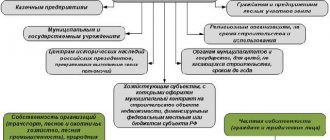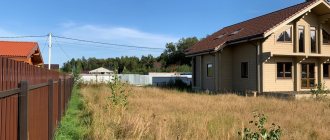Often it is not possible to determine the order of use of a land plot peacefully.
Our lawyer on land issues will tell you how to do everything correctly and without unnecessary mistakes. With the help of a specialist in your field, you will not only decide on the procedure for using the land, but also eliminate the obstacles in using the land that third parties put in your way.
The procedure for determining the procedure for using a land plot
The owner of each apartment in a common building has the right to receive a certain share in the surrounding territory, regardless of the fact that neighbors’ buildings are already located on it.
The main criterion that will guide the official (judge) will be the determination of the share of all participants in the process in the right to use a specific territory. All rights and obligations of the parties are described in the Civil Code of the Russian Federation and the Land Code of the country, which states that the owner of half of the house has the right to half the share of the land around it, and the one who owns 1/5 of the house receives the right to 1/5 of the land around it .
The second criterion in resolving this land issue will be the order that has developed over the years, which was determined from the convenience of each land user, the location of his buildings on the land plot, as well as taking into account plantings of bushes and fruit and berry trees. Thus, the basis for the decision is the tradition of land use that has already been determined over the years, even if it does not correspond to an equal ratio in the common property, all inequalities are compensated by cutting or trimming in another place of the site where the dispute is least clear. The order of land use established over a long period of time is often recognized as logical, including when housing owners change. Repeated appeal to court on the same issue is prohibited by law.
Who can sue to determine the order of use of a land plot?
- Citizens of private houses. Such disputes are different from those that begin when it is impossible to determine the boundaries of plots or to prove ownership. In this case, absolutely all citizens of the country can turn to judges for help.
- Residents of apartment buildings. Determination of the procedure for using a land plot is most often required by owners of houses designed for use by several owners at once because and they have common land, often without any definite division. More questions of order arise when transferring the category of land; not all adjacent land users are satisfied with the decision made to change the purpose of the land plot; litigation begins on this issue.
ATTENTION: A lawyer on land disputes in court with neighbors and third parties gives advice in the video. Subscribe to our YouTube channel and legal advice on land issues in the comments of the video will be free for you.
Positions by section.
1. As is known, in accordance with paragraph 1 of Art. 252 of the Civil Code of the Russian Federation, property that is in shared ownership can be divided between its participants by agreement between them. Paragraph 3 of this article establishes that if the participants in shared ownership fail to reach an agreement on the method and conditions for the division of common property or the allocation of the share of one of them, the participant in shared ownership has the right to legally demand the allocation in kind of his share from the common property 2. When dividing a land plot and located on it, real estate objects are transferred to each of the co-owners into ownership of certain parts of the land plot, isolated parts of a residential building located on the land plot, and buildings for economic purposes, based on their shares in ownership. 3. The presence of unauthorized buildings in itself is not a legal basis for refusing to allocate to co-owners the parts of the land plot occupied by such buildings that are in their actual use. When choosing a division option, the court has the right to take into account all buildings located on the land plot as evidence of actual land use.
4. The court shall refuse to satisfy the claim for division of common property if division in kind is impossible without disproportionate damage to property in common ownership.
Disproportionate damage to property in common ownership should be understood as the impossibility of using the property for its intended purpose, a significant deterioration in its technical condition or a decrease in value, inconvenience in use, etc.
If the allocation of a share in kind is not permitted by law or is impossible without disproportionate damage to property in common ownership, the allocated owner has the right to have the value of his share by other participants in shared ownership.
In paragraph 36 of the resolution of the Plenum of the Supreme Court No. 6, the Plenum of the Supreme Arbitration Court of the Russian Federation No. 8 dated 01.07.1996 “On some issues related to the application of part one of the Civil Code of the Russian Federation” it is explained that if it is impossible to divide property between all participants in common property or allocation of a share in kind to one or more of them, the court, at the request of the allocated owner, has the right to oblige the remaining participants in the shared ownership to pay him monetary compensation , upon receipt of which the co-owner loses the right to a share in the common property 5. It should be noted that the technical feasibility of the real division of the house is determined by the Rules and standards for the technical operation of the housing stock , approved by Resolution of the Gosstroy of Russia dated September 27, 2003 No. 170, in conjunction with which the Departmental Construction Standards of the State Committee for Architecture and Urban Planning under the Gosstroy “Reconstruction and major repairs of residential buildings. Design standards VSN 61-89 (r.)" (approved by order of the State Committee for Architecture and Urban Planning under the USSR State Construction Committee dated December 26, 1989 No. 250), provisions of the Methodological Recommendations for solving expert problems related to the actual division of households when courts consider legal disputes ownership of real estate in the housing sector.
At the same time, the technical possibility of actually dividing a house is limited by a number of conditions, namely: the degree of its physical wear and tear should not exceed a critical limit - 70% for stone residential buildings and 65% for wooden residential buildings.
6. The division of a land plot is not allowed if, as a result of the division, land plots are formed whose area is less than the minimum size of land plots, in respect of which, in accordance with the legislation on town planning activities, town planning regulations are established. In addition, additional criteria for the divisibility of land plots are established by Art. 11.9 Land Code of the Russian Federation .
Division of a land plot is possible subject to its divisibility, i.e. with the formation of each of its parts as an independent land plot with the same permitted regime of use (Article 6 of the Land Code of the Russian Federation).
According to paragraph 1 of Art. 11.4 of the Land Code of the Russian Federation, when dividing a land plot, several land plots are formed, and the land plot from which land plots are formed during division ceases to exist.
Art. 11.9 of the Land Code of the Russian Federation establishes requirements for the formed and modified land plots, in particular, they must meet the maximum (maximum and minimum) sizes of land plots determined by urban planning regulations, in respect of which, in accordance with the legislation on urban planning activities, urban planning regulations are established. When dividing a land plot or allocating a share in kind from it, new land plots are formed, which are subject to land and town planning legislation in force at the time of their formation.
In accordance with paragraph 2 of part 3 of Article 27 of AP dated July 24, 2007 No. 221-FZ “On the State Real Estate Cadastre,” the cadastral registration authority makes a decision to refuse to register a land plot if the size of the land plot being formed or the land plot that as a result of the transformation, it remains within the changed boundaries (changed land plot), will not comply with the requirements established in accordance with federal law for the maximum (minimum or maximum) sizes of land plots. 7. In accordance with paragraph 4 of Art. 41 of the Civil Code of the Russian Federation, a mandatory condition for dividing a land plot into several land plots is the presence of entrances and approaches to each formed land plot.
In addition, the consolidation of land plots into one land plot is allowed only if the formed land plot is located within the boundaries of one territorial zone.
Additional criteria for the divisibility of land plots are established by Art. 11.9 of the Land Code of the Russian Federation, namely:
— the boundaries of land plots should not cross the boundaries of municipalities and (or) the boundaries of populated areas;
- the formation of land plots is not allowed if their formation leads to the impossibility of the permitted use of real estate located on such land plots;
- division, redistribution or allotment of land plots is not allowed if the encumbrances (restrictions) retained in relation to the land plots being formed do not allow the use of these land plots in accordance with the permitted use;
— the formation of land plots should not lead to wedging, interspersing, broken boundaries, interstriations, the impossibility of placing real estate objects and other shortcomings that impede the rational use and protection of land, and also violate the requirements established by the Land Code of the Russian Federation and other federal laws.
8. If there is a real possibility of dividing a land plot and real estate located on it in kind in accordance with ideal shares monetary compensation should not be recovered if a co-owner objects to its receipt, since the right to dispose of property belongs only to the owner himself and he can be deprived this right only in cases and on the grounds specified in the law.
9. When dividing a land plot, it is necessary to take into account the size of the ideal shares of each of the co-owners, the divisibility of the land plot, the possibility of dividing the land plot, taking into account the divisibility of the real estate located on it and the absence of disproportionate damage to property in common ownership, the established procedure for using the land plot and real estate objects located on it, the cost of the necessary construction and technical work. 10. When dividing a residential building located on a common plot of land, it is necessary to decide the legal fate of all outbuildings . If there are no such requirements in the pleading part of the claim (and, accordingly, in the operative part of the decision), this issue will have to be resolved with an additional decision.
Agreement on determining the procedure for using a land plot
In the event that several owners of the same land plot have disputes regarding the order of use of the land, it is possible to determine the order of use by concluding an appropriate agreement. Such an agreement is a good way of out-of-court settlement of a dispute related to the use of a land plot.
It must be remembered that the procedure for using a land plot in shared ownership can be changed. Moreover, it can be changed again out of court, and again by concluding an agreement or an annex to it. I would like to note that such an agreement is not subject to registration with any government bodies and begins to operate from the moment it is signed (unless it provides for something else).
It is also worth remembering that determining the procedure for using land is not a division of the land plot and, accordingly, does not have the same legal consequences.
It is important to remember that the agreement is drawn up in writing and must contain:
- The date and place of its compilation;
- Data of all legal holders of the land plot;
- General rights and obligations of all site owners;
- Specific rights and obligations of specific site owners;
- The procedure for using communications (if any and are common).
It is worth noting that if the owners of the plot have not come to an agreement on the definition of the use of the land, then a judicial procedure can come to the rescue, the main purpose of which will be to change the order of use of the land plot; this category of disputes is quite common. If it was not possible to reach an agreement, our lawyers will help you draw up a competent statement of claim to determine the procedure for using the land plot, which will increase the chances of a successful resolution of the case in court.
Related documents
- Sample. Statement of claim for the release of property from seizure and exclusion from the inventory
- Sample. Statement of claim for the release of property from seizure and exclusion from the inventory
- Sample. Statement of claim to cancel the decision of the general meeting of founders
- Sample. Statement of claim to reduce the amount of alimony
- Sample. Statement of claim to reduce the amount of alimony
- Sample. Statement of claim for a reduction in the amount of alimony, for exemption in whole or in part from payment of the resulting alimony debt
- Sample. Statement of claim to establish paternity and collect alimony
- Sample. Statement of claim to establish paternity and collect alimony
- Sample. Cassation appeal against the court verdict
- Sample. Cassation appeal against the court's decision to invalidate the exchange agreement and restore the missed deadline for a cassation appeal
- Sample. Cassation appeal against a court decision in a civil case
- Sample. Cassation appeal against the court decision on the claim for reinstatement (short)
- Sample. Cassation appeal against the court's decision on a claim for reinstatement at work (a reasoned cassation appeal in addition to the previously filed short cassation appeal)
- Sample. Cassation appeal on a claim for recovery of interest due to failure to fulfill obligations under a deposit agreement
- Sample. Settlement agreement on compensation under a bank deposit agreement
- Sample. Settlement agreement on payment of part of the plaintiff’s claims under the statement of claim
- Sample. Response to the contractor's claim for payment of the cost of materials
- Sample. Response to the statement of claim in defense of state and public interests (in accordance with Article 109 of the Arbitration Procedure Code of the Russian Federation)
- Sample. Response to the statement of claim for recovery of the cost of undelivered goods (in accordance with Article 109 of the Arbitration Procedure Code of the Russian Federation)
- Sample. Guarantee of a public organization
Claim to determine the procedure for using a land plot
- Site use plan. We recommend that you prepare for the court reasonably and come to the court hearing with pre-prepared options for the proposed division of the land plot. These diagrams are made on the basis of data from geodetic services by specialists who have access to this type of work. This will make it easier for you to explain to the court and other participants in the process how you imagine joint use of the land is possible.
- Objections. The second party to a land dispute regarding the boundaries of land plots is not deprived of the opportunity to present their options, as well as to petition for the appointment of a judicial land management examination, within the framework of which the long-term land conflict between the warring parties will be put to an end.
- Prove the existing order. To prove your position, it would not be superfluous to raise all the BTI plans that take place. The old diagrams, although not accurate, give an idea of how the buildings were previously located, what angle of inclination the border between the plots had, etc.
USEFUL: watch more tips on filing a claim in our video on YouTube channel
Filing a claim and considering the case
The plaintiff is guided by the general rules for filing a claim. The case will be heard by the district court. And at the location of the land plot. The state duty is 300 rubles. Before filing the documents, the defendant must send (hand over against signature) the second set of the claim and documents thereto.
The court considers the case in a general manner. Conducts preliminary and main court hearings. Often, a land survey may be carried out in connection with a case. In this case, paragraph 2 of paragraph 37 of the resolution of the Plenum of the Supreme Court of the Russian Federation No. 6, Plenum of the Supreme Arbitration Court No. 8 of July 1, 1996 is often used. When considering a claim to determine the procedure for using real estate, the court takes into account:
- the actual established procedure for using property, which may not exactly correspond to the shares in the right of common ownership, the need of each of the co-owners for this property and the real possibility of joint use.
Help from a lawyer on land disputes in Yekaterinburg
Each side tries to prove its right to a larger meter. The issue of the correct installation of the fence becomes the most discussed in the dispute between neighbors. In such cases, you should file a claim in court and prove your case within the legal framework, and not continue a meaningless discussion that does nothing except waste time.
It is also worth understanding that when resolving cases of this category, the principles for determining the procedure for using a land plot are very important:
- the principle of equal rights to a land plot;
- the principle of reasonableness and justice.
To protect your land rights and receive the support of state judicial authorities, you should enlist the support of an experienced land lawyer, in particular you can find one in our organization. Only a legally savvy person is able to somehow change the tradition of owning a land plot and give the owner the right to use his share as he wishes.
When is this required?
In practice, there are often situations when the plot is in common ownership, that is, it has several owners at once.
The share of each of them can be determined in documents, and sometimes there may not be data on this (then the rights are considered equal). Common property arises on one of the following grounds:
- joint acquisition of a plot, when initially the shares of each co-owner were not allocated;
- purchase of land by one of the spouses during marriage, if the property is ultimately recognized as jointly owned. Contradictions may arise in the event of divorce and subsequent division of property;
- donation of a plot to several persons at once;
- inheritance of a plot, when allocating a share to each heir was not feasible;
- other reasons.
In this case, rights to the site are exercised on a joint basis. But it is not always possible for individuals to agree on specific circumstances and some features of the common use of land. One believes that he has more rights for some reason, the other that others are abusing their rights. The result is growing contradictions.
Link to document:
What is shared ownership?
Shared ownership means that an object (house, apartment, plot) has several owners at once. At the same time, the size of each person’s share in the common property is strictly fixed. An entire chapter of the Civil Code is devoted to the concept of common ownership. According to the document, the presence of two or more owners makes the property common (Article 244 of the Civil Code of the Russian Federation). It can be of two types:
- without allocation of shares (joint);
- with determination of the share of each owner (shared ownership).
The sizes of shares may vary: both equal parts and any other ratios are acceptable.
Basic principles for using a plot of land in shared ownership:
- each of the owners receives for use a part of the land plot in proportion to the allocated share (Article 247 of the Civil Code of the Russian Federation);
- At the same time, all other property located on its territory is distributed: plants, grown fruits, etc. (Article 248 of the Civil Code of the Russian Federation);
- expenses for maintaining real estate are also divided among all participants, in accordance with the size of their shares (Article 249 of the Civil Code of the Russian Federation);
- each owner has the right to dispose of his share at his personal discretion: it can be sold, given as a gift, etc. (this can only be done after obtaining the permission of all other owners of the site - by law they have a pre-emptive right to purchase the alienated share) (Article 246 of the Civil Code RF).
Important! A plot of land that is in shared ownership is assigned one cadastral number. At the same time, the USRN extract separately records the share of each participant in the joint ownership. If desired, the share can be separated into an independent object. It will be registered under a separate cadastral number (Article 252 of the Civil Code of the Russian Federation).
On our website you will find other publications on the topic of using land, from which you can learn:
- What is the procedure and grounds for granting land?
- Where to apply for the allocation of a site and what to do if the administration refuses?
- Who is entitled to benefits?
- How does loss of use rights occur?
- What is preliminary approval and how does it happen?
- How to file a claim to remove obstacles to the use of a land plot?
Share allocation
The best option to avoid conflict between co-owners is to allocate the shares of each, designating the plots into separate, separate possessions.
This will make it possible to completely divide the land of each participant in the relationship and subsequently minimize any communication between individuals, if there is such a need. The possibility of allocation is enshrined in paragraph 1 of Article 11.2 of the Land Code of Russia. The procedure is implemented both on the basis of an agreement concluded between the co-owners, and through the court, if an agreement cannot be reached.
Allocation, if one of the parties disagrees, is carried out only through the court. However, as part of the process, cadastre authorities are involved, as well as land experts.
If allotment in kind is impossible for some reason, then the person who initiated the procedure has the right to count on compensation from the remaining co-owners.
For example, if on a certain part there are communications that cannot be moved and the border has to be moved, the person who ends up with less than his share will receive compensation at market value. Its size is determined by expert opinion.
When separation is not possible
It is not always possible to actually allocate a share. In some cases, the land will remain joint property. If the shares of each co-owner were not previously determined, then it is allowed to transfer the property into a joint share, but it may be impossible to determine the share of each in kind for the following reasons:
- area too small;
- selection in kind is physically impossible due to the location or communications passing through it.
The legislator established the minimum area for allocation. If after the examination it turns out that the area of the site does not meet the established standards, the procedure will not be implemented. For allotment in kind, the following minimum sizes are established for each category of land:
- for personal farming - this is 4 acres;
- gardening and vegetable gardening - from 6 acres;
- agricultural plots – 2 or more hectares.
Municipal authorities may change the minimum sizes of plots allowed for allocation.
So, if allotment is impossible, the co-owners can either accept the established procedure or determine the size of their share in relation to existing circumstances.
The current order
If the common ownership of land is of a continuing nature, the order of use of the land may develop naturally. For example, over the course of decades, part of the area may be given over to flower beds and flower beds, and neighbors in the plots mutually recognize this order of use. In the absence of mutual disputes, co-owners can use the site without a written agreement.
By mutual agreement, the following land use conditions may be provided:
- providing certain parts of the common allotment to different citizens for gardening, horticulture, placement of outbuildings, etc.;
- determining the mode of use of public utility facilities - for example, a water supply well or a natural reservoir;
- determination of passage points through the site to buildings, etc.
Under the current land use procedure, each of the co-owners may require a written agreement. In addition, such a need may arise when a new owner receives rights to a building or site - he has the right to agree with the existing procedure for use, or to demand changes to its conditions. If the parties do not mutually agree to change or maintain the previous conditions, they will have to formalize an agreement or go to court.









